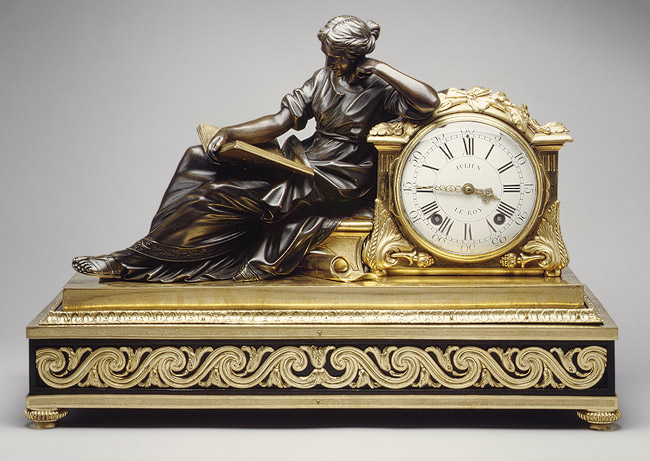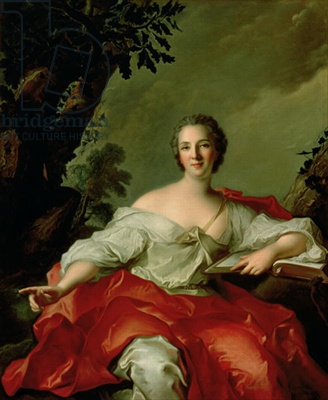L'Emploi du Temps, A Monumental Parcel-Gilt, Bronze and White
Carrara Marble Horloge à Poser
Carrara Marble Horloge à Poser
After the design by Joseph Baumhauer, Paris, circa 1865
The clock face with enamelled signature JULIEN LEROY A PARIS, the twin train movement stamped H/1050/10 10, the figure holding an open book inscribed on the left page NERON CH. XXIX Ce monstre ordonna la mort de sa mère, et termina sa vie par un suicide and inscribed on the right page TITUS CH. XXX J'ai perdu ma journée quand je ne l'ai pas signalée par un bienfait, the marble with two stencilled stamps to the underside MERCIER/AINE
36 ½ in (92.5 cm) high, 45 ½ in (115.5 cm) wide, 16 ¼ in (41.3 cm) deep
cf. Geoffrey de Bellaigue, The James A. de Rothschild Collection at Waddesdon Manor, Vol. I, 1974, pp.104-107, no.17
Peter Hughes, The Wallace Collection, Catalogue of Furniture, Vol. I, 1996, pp.440-443, no. 99 (F267)
36 ½ in (92.5 cm) high, 45 ½ in (115.5 cm) wide, 16 ¼ in (41.3 cm) deep
cf. Geoffrey de Bellaigue, The James A. de Rothschild Collection at Waddesdon Manor, Vol. I, 1974, pp.104-107, no.17
Peter Hughes, The Wallace Collection, Catalogue of Furniture, Vol. I, 1996, pp.440-443, no. 99 (F267)
The model of the seated woman reading that adorns this clock is entitled L'Emploi du Temps (Time's Employment) and was first sculpted by the little-known sculptor Laurent Guiard (1723-88), pupil of the sculptor Edmé Bouchardon (1698-1762). The model of the woman is closely related to the enduring, popular model named after Marie Thérèse Rodet Geoffrin (26 June 1699 - 6 October 1777), a French woman of humble origin who rose to a position of considerable power in French society and hosted an influential Parisian salon. Other notable members of Madame Geoffrin's circle who owned 'une pendule à L'Emploi du Temps' included the banker Jean-Joseph de Laborde, the duc de la Vrillière and Horace Walpole at Strawberry Hill. Walpole's clock, which he purchased before 1774, is probably the clock now at Waddesdon Manor. The duc de Choiseul owned an example which can be seen on a cartonnier probably by Simon Oeben, in a miniature by van Blarenberghe from the Choiseul Box, circa 1770-1 showing the cabinet octagone in the hotel de Choiseul in Paris.
This design proved one of the most popular in 18th-century France, and the workshop of Julien Le Roy was among the suppliers of movements for such clocks. The dial on the clock could be from the 18th century. Known as the most inventive clockmaker in 18th-century France, Julien Le Roy contributed significantly to the development of the marine chronometer. He was appointed clockmaker to Louis XV, an honour that entitled him to a workshop in the Louvre. After Julien's death, his son Pierre Le Roy (1717-1785) was granted continued use of the workshop. He used his father's name to sign workshop products, and it is therefore difficult to separate the clocks made before and after Julien's death.
The original model by Baumhauer is held in the collections at the Metropolitan Museum of Art. An identical example of the 18th-century model with a movement by Le Roy, raised on an ebony base, may be found at Waddesdon Manor, and another example with a movement by Berthoud, also on an ebony base, may be seen in The Wallace Collection. This clock is impressive by its sheer scale and size and would have been a focal point for an opulent interior in the 19th century.
This design proved one of the most popular in 18th-century France, and the workshop of Julien Le Roy was among the suppliers of movements for such clocks. The dial on the clock could be from the 18th century. Known as the most inventive clockmaker in 18th-century France, Julien Le Roy contributed significantly to the development of the marine chronometer. He was appointed clockmaker to Louis XV, an honour that entitled him to a workshop in the Louvre. After Julien's death, his son Pierre Le Roy (1717-1785) was granted continued use of the workshop. He used his father's name to sign workshop products, and it is therefore difficult to separate the clocks made before and after Julien's death.
The original model by Baumhauer is held in the collections at the Metropolitan Museum of Art. An identical example of the 18th-century model with a movement by Le Roy, raised on an ebony base, may be found at Waddesdon Manor, and another example with a movement by Berthoud, also on an ebony base, may be seen in The Wallace Collection. This clock is impressive by its sheer scale and size and would have been a focal point for an opulent interior in the 19th century.


















